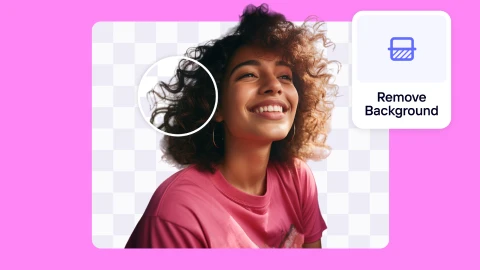Your guide to creating professional posters with AI
Poster design requires either professional design skills or a significant budget to hire a designer. But that's changed dramatically with the rise of AI design tools. It has become as simple as writing an instruction (i.e., prompt) to get a professional poster. This guide will take you through everything you need to know about creating professional posters with AI, including:
Essential planning steps to ensure your poster achieves its goals
Step-by-step instructions for creating both digital and print posters
All the important elements your poster should contain
What to do before designing your poster
Before opening any design tool, taking time to plan your poster will significantly improve your results.
Define your poster’s purpose or goals: Are you trying to boost sales for a specific product or service? Promote an upcoming event? Share important information? Understanding the purpose of your poster will help you create a design that is focused and impactful.
Think about what success looks like for this project. Is it getting more registrations for your event, increasing sales of a featured item, or driving traffic to your website via a QR code? Defining these goals upfront is crucial. A great pro tip is to write down one primary goal and any secondary objectives. This way, you can prioritize your messaging and make better design choices later on, ensuring every element of your poster serves a clear purpose.

Identify how you'll measure success, i.e., metrics: Once you’ve outlined your goals, think about how you’ll track the success of your poster. Metrics might include the number of event registrations you receive, the scan rate of your QR code, or the sales generated from a specific promotion. These measurements will help you understand whether your poster is achieving its intended results.
Know your audience characteristics: A successful poster speaks to the right audience. To achieve this, you need to know who you’re designing for. Consider the age range, preferences, and behaviors of the people you’re trying to reach. Are they teenagers who are drawn to bold, trendy designs? Adults who prefer clean, professional layouts? The more you understand your audience, the better you can tailor your design to grab their attention and inspire them to act.
Consider where and how your audience will see your poster: Context matters when it comes to poster design. Where and how your audience encounters your poster can drastically affect how you design it. For example, a poster meant to catch someone’s attention as they walk past a busy street needs bold fonts, eye-catching visuals, and minimal text. On the other hand, a poster shared on social media can include more details since viewers will have time to stop and read. If your poster is going up in a retail location, it might focus more on in-store promotions or product details. Thinking about the placement and context of your poster will help you make design choices that ensure your message lands effectively.
What are the elements of a good poster?
Every successful poster, whether digital or printed, needs certain key elements to be effective. Think of these as your poster's must-haves.

A strong headline: Your headline is the first thing people see, and it needs to grab attention immediately. Make it bold, clear, and large enough to read from a distance. For digital posters, ensure they are readable even as thumbnails. Your headline should instantly tell viewers what the poster is about, whether that's a sale, an event, or important information.
Clear contact information: Never make people hunt for ways to reach you. Include the essential details they need to take action such as social media handles, physical address, phone number, etc. Or a QR code linking to these.
A compelling call-to-action (CTA): Tell people exactly what you want them to do. For example, Shop Now, Book Your Spot, Register Today, Visit our Store, etc. Your CTA should be obvious and action-oriented. It should stand out visually.
Key details: Don't leave out the crucial information your audience needs such as dates and times, prices and offers, location details, etc.
Brand elements: Your poster should be instantly recognizable as yours, so be sure to include your logo and design it in your brand colors and style.
High-quality visuals: Whether it's photos, graphics, or icons, your visual elements need to be clear, properly sized, well-positioned, and relevant to your poster message.
Readable text: All text on your poster must be easily readable so use clear font choices that have good contrast with the background and are properly spaced.
White space: White space is not necessarily a bad thing, it helps you not overcrowd your poster. So, leave enough breathing room around the main components of your poster.
Remember, while you need all these elements, you don't need to overthink them. Modern AI tools handle many technical aspects automatically, letting you focus on crafting your message. The key is ensuring each element serves a purpose and works together to create a poster that achieves your goals.
How to create a poster with AI in a few steps
Creating a professional poster has never been easier thanks to AI design tools. In this comprehensive guide, we'll walk you through every step of creating an eye-catching poster using AI, with Photoroom AI poster maker as our tool of choice for its powerful features and user-friendly interface.
1: Setting up your project
Before diving into the creative process, it's crucial to start with the right foundation. First, you need to know your poster size. Instagram has a square size of 1080 x 1080 pixels (square), while Facebook has 1200 x 628 pixels. Then organize your materials, i.e., know what you want to include in the poster. Have your main headline, supporting text, CTA, etc ready.
2: Access the AI poster maker
You have two ways to start your poster creation journey. You can do a quick start, that means you follow these steps:
Open Photoroom
Click the + icon in the interface
Select "Generate an image with AI" from the Insert menu
Choose "Poster maker" from the AI tools

Open Photoroom and scroll to "Start with a Blank Canvas"
Click “Custom” and enter your desired custom dimensions in pixels.
Once in the editing area, click the Insert option
Select "Generate an image with AI"
Choose "Poster maker"

3: Craft the perfect prompt
The key to create a poster with AI efficiently is writing detailed AI prompts. A very effective prompt will include details about the:
Main subject or focus
Desired mood or atmosphere
Color preferences
Any specific elements you want to include
Style preferences
For example, instead of “coffee shop poster for 50% off,” a better prompt would be “A modern coffee shop poster for Reyna Beans with a to go coffee cup as the main focus. Add warm brown tones, announcing 50% off as a headline and “Chilly winter discount” as a sub-headline. Show Reyna Beans in the poster”
Quick tip: If I’m struggling with coming up with detailed prompts, I find a poster I like on Pinterest and upload it to ChatGPT. Then, I ask ChatGPT to give me a detailed description of the mood, color tone, style, etc. This gives me prompt inspiration. A neat, little trick.
4: Choose your format and style
The Photoroom AI poster maker allows you to also select your design size and style. The style here is to determine what all your outputs will look like. You can select from five poster sizes which include:
Square: Perfect for Instagram posts
Portrait 3:4: Ideal for Pinterest and Instagram
Portrait 9:16: Great for Stories and TikTok
Landscape 4:3: Good for Facebook and presentations
Landscape 16:9: Ideal for digital displays and headers
There are also a variety of styles which include:
Diversity: Multiple random styles
Vintage: For retro and nostalgic feels
Minimalist: Clean and modern designs
Colorful: Vibrant and eye-catching
Hand-drawn: Artistic and personal touch
Photographic: Realistic and professional
Typographic: Text-focused designs
Abstract: Modern and artistic
Grunge: Edgy and urban
Pop Art: Bold and contemporary
For this tutorial, I have selected Portrait 3:4 and a Photographic style with the prompt in Step 3 above.

5: Review and select
Once you have put all these in place, Photoroom will generate four variations of your poster for you to choose from. To make the most of this stage, look at each variation carefully, check the readability of any text, and consider how well the image matches your vision. If you want more variations, you can adjust your prompt and experiment with different styles. You will keep getting four new variations every time you try.
Once you find the one that works, click on it, and select “Use image” or tweak that specific one for your needs. This will take you back to the editing area with your poster ready to go.
By the way, if you change your mind and want to use a different design, simply tap on the poster and click “Replace.” Follow Step 2 to access the poster maker with all your previous variations.
6: Add other elements as necessary
You can include other elements to your poster such as your brand logo, text, stickers, and other accessories.
To do that, click on Insert to access Photoroom’s elements library where you will find icons, logos, accessories, promotion stickers, and much more.
7: Export your poster
Once you're happy with your design, click the purple Export button or the Export icon at the top right corner and the poster automatically saves to your photo gallery. You can also share the design with other people to collaborate on your design and add other elements more cohesively. You can check out my coffee poster design here.

Types of poster styles and how to achieve them with AI
There are different types of poster styles that are best suited for different purposes. I will show you what they look like using detailed prompts with Photoroom AI poster maker:
Informative/text-centric
Informative posters prioritize content, featuring clear text hierarchies, organized sections, and easy-to-read layouts. They are ideal for educational materials, conferences, and research presentations where the audience needs to absorb detailed information quickly.
Prompt: Informative poster for a new yoga class at a studio called 'WinWell'. The design should feature a clean, calming layout with soft, earthy colors like sage green, beige, and white. Headline: "Join Our New Yoga Class at WinWell Studio". Subheadings: "March 10, Rockefeller Studio, Taught by Sarah Thompson" Social media handle: '@WinWellYoga' Use simple, modern sans-serif fonts, and add yoga elements like mats and silhouette poses.

Minimalist
A minimalist poster style focuses on clean, simple designs with lots of white space and minimal text. The look is modern, polished, and sophisticated, making it perfect for luxury brands, professional services, and modern tech companies. This style lets the key message or image shine without any distractions.
Prompt: Minimalist poster for a luxury jewelry company’s new diamond product launch. Use a clean, simple design with a white or light gray background. Include a sleek, modern font for the headline and minimal text beneath it. Keep the layout spacious and uncluttered with plenty of negative space.

Bold and vibrant
The bold and vibrant style is all about grabbing attention with eye-catching colors, large typography, and striking visuals. It’s perfect for sales promotions, festivals, retail events, or any campaign that needs to create excitement and energy.
Prompt: A bold and vibrant poster for a summer music festival happening on January 15th, 2025, in Venice. Use bright, eye-catching colors like red, yellow, or neon tones. Feature large, thick typography for the headline and include dynamic graphic elements like geometric shapes, paint splashes, or zigzag patterns to add energy and excitement.

Photo-centric
Photo-centric posters put high-quality images front and center, with minimal text to keep the focus on the visuals. This style works especially well for industries like fashion, food, travel, or entertainment, where imagery tells the story.
Prompt: Create a photo-centric poster for a luxury fashion collection release. Use a large, high-quality image of a model wearing the collection as the focal point. Include minimal text, such as a sleek headline like “Spring ’25 Collection” and a small subheading with the release date. Use soft, muted colors like beige, cream, or pastel pink for accents, and make sure the text is clean and unobtrusive to keep the focus on the image.

Artistic/creative
The artistic and creative style embraces unique visual elements, experimental typography, and unconventional layouts. It’s perfect for art events, music shows, or creative industries that want to stand out with a bold, expressive design.
Prompt: Create an artistic poster for an abstract art exhibition titled “Visions of Color,” running from February 20th to March 10th, 2025, in New York City. Use experimental, eye-catching typography for the headline and incorporate unique visual elements like paint strokes, hand-drawn shapes, or layered textures. Choose a vibrant yet sophisticated color palette featuring deep blues, reds, and gold, and aim for a creative, slightly unconventional layout that reflects the exhibition’s artistic theme.

Why should you create posters for your business?
If you are wondering if posters still have a place in your marketing strategy in 2025, they do!. Posters have evolved beyond paper and print. Social media has given posters new life and unprecedented reach. A well-designed digital poster can stop thumbs from scrolling and eyes from wandering.
Digital posters for social media marketing
Digital posters are a fantastic way to grab attention on social media and share important updates with your audience. They’re perfect for announcing sales, events, or product launches, basically, anything you want people to know about quickly and in style. A bold, eye-catching design can stop someone mid-scroll and get your message across in just seconds.
If you’re running a time-sensitive promotion, digital posters help you build excitement and urgency, with a well-placed countdown, encouraging your followers to act fast before the offer ends.
To make things even more interactive, try adding fun elements like polls or questions to your posters. If your goal is to drive traffic or sales, you can include swipe-up links or direct call-to-action buttons so people can take action immediately.
Physical posters for local advertising
Physical posters are a tried-and-true way to draw attention to your business in your local area. Placing a bold, eye-catching poster in your store window is an easy way to catch the attention of people walking by. Whether someone is casually passing or intentionally browsing, a well-placed poster can spark their curiosity and bring them through your door.
If you’ve just launched a new product or service, a poster can be the perfect way to introduce it to the community. With a clear design and a strong message, it’s easy to grab attention and get people interested.
Physical posters are also excellent for creating a sense of urgency. Limited-time offers or exclusive deals become even more tempting when they’re announced in big, bold letters right where people can see them.

Posters for hybrid marketing
Posters are a perfect tool for bridging the gap between physical and digital marketing. By integrating QR codes into your physical posters, you can direct people straight to your online store, event page, or social media profiles with just a quick scan. It’s an easy way to combine the best of both worlds, grabbing attention offline and leading customers online where they can take immediate action.
You can also use posters to promote digital menus, catalogs, or resources. For example, a poster in your café or store could feature a QR code linking to your full menu or product catalog, saving customers time and making their experience more seamless. This is especially handy for businesses that want to reduce paper waste while offering customers more information than what fits on a traditional poster.
Another benefit of hybrid marketing with posters is the ability to track their effectiveness. With unique QR codes or links for specific posters, you can monitor how many people engage with them and where they’re scanning from. This data can help you fine-tune your marketing strategy, ensuring your posters are not only eye-catching but also driving measurable results. Hybrid posters give you the flexibility to connect with your audience on multiple levels, making them a smart addition to any marketing plan.
Why should you create posters with AI?
1. No design experience needed: Traditional design work can be intimidating for those without training, but AI tools are built with simplicity in mind. With AI handling the technical aspects, you can focus on the creative side, ensuring your message shines through.
2. Professional results in minutes: AI design platforms are built for speed without sacrificing quality. In just a few clicks, what once might have taken hours or days to create can now be done in minutes, giving you professional-grade materials without the long wait times. .
3. Significant cost savings vs. hiring designers: Hiring a professional designer can be costly, especially for a small business or solopreneur. Even more costly if you require multiple revisions or frequent updates. With AI, you can achieve similar results for a fraction of the cost. Many AI design tools offer affordable subscription plans or pay-per-project options, making it easy to stick to your budget.
4. Time savings for busy professionals: For individuals balancing multiple responsibilities, AI tools provide an efficient solution to the time-consuming design process. Instead of spending hours learning complex software or communicating ideas back and forth with a designer, you can generate high-quality posters quickly and independently.
5. Unlimited design variations: Unlike traditional methods where each design requires starting from scratch, AI platforms let you explore countless design variations in minutes. You can easily try different styles, layouts, and color schemes, tweaking them until they perfectly match your vision.
Create engaging posters with AI
You do not need to be a professional graphic designer or spend hundreds of dollars to create a poster with AI. You can easily use Photoroom on any of your devices (Web, iOS, or Android). Create a free account to get started.
FAQs
Can AI create a poster?
Yes, AI can create a professional-quality poster quickly and easily. With AI-powered tools like Photoroom AI Poster Maker, you can generate stunning designs without any prior experience.
How much does it cost to create a poster using AI?
The cost of creating a poster with AI varies depending on the platform you use. Many tools offer free versions with basic features, while premium plans with advanced design options can cost anywhere from a few dollars per month to a flat project fee. Regardless, AI poster creation is significantly cheaper than hiring a professional designer.
Can I use the same poster for both print and digital formats?
Absolutely! Most AI design tools allow you to download posters in high-resolution formats suitable for both print and digital use. Just ensure that your design uses the correct dimensions and resolution for each platform.
How long does it take to create a poster with AI?
Creating a poster with AI is incredibly fast. Depending on the complexity of your design, it can take as little as 5-15 minutes to create a fully polished poster. Tools with ready-to-use templates and auto-layout features allow you to finalize your design in a fraction of the time it would take using traditional methods.




Design your next great image
Whether you're selling, promoting, or posting, bring your idea to life with a design that stands out.
















